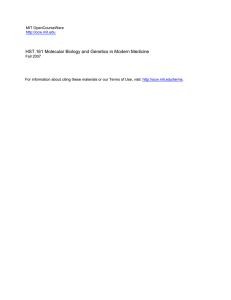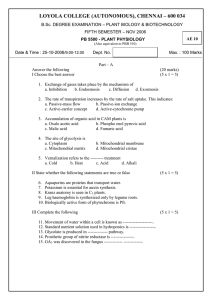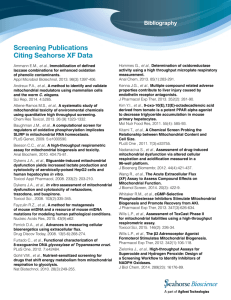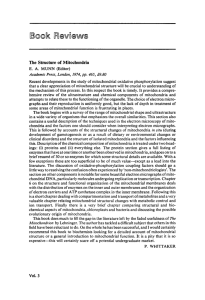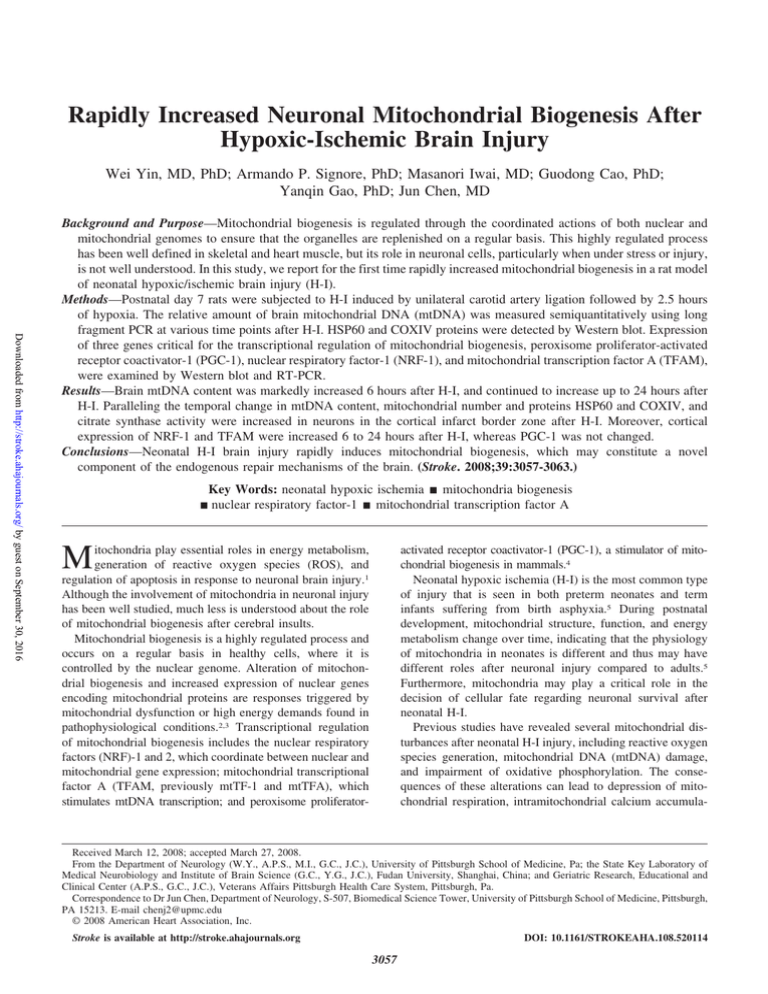
Rapidly Increased Neuronal Mitochondrial Biogenesis After
Hypoxic-Ischemic Brain Injury
Wei Yin, MD, PhD; Armando P. Signore, PhD; Masanori Iwai, MD; Guodong Cao, PhD;
Yanqin Gao, PhD; Jun Chen, MD
Downloaded from http://stroke.ahajournals.org/ by guest on September 30, 2016
Background and Purpose—Mitochondrial biogenesis is regulated through the coordinated actions of both nuclear and
mitochondrial genomes to ensure that the organelles are replenished on a regular basis. This highly regulated process
has been well defined in skeletal and heart muscle, but its role in neuronal cells, particularly when under stress or injury,
is not well understood. In this study, we report for the first time rapidly increased mitochondrial biogenesis in a rat model
of neonatal hypoxic/ischemic brain injury (H-I).
Methods—Postnatal day 7 rats were subjected to H-I induced by unilateral carotid artery ligation followed by 2.5 hours
of hypoxia. The relative amount of brain mitochondrial DNA (mtDNA) was measured semiquantitatively using long
fragment PCR at various time points after H-I. HSP60 and COXIV proteins were detected by Western blot. Expression
of three genes critical for the transcriptional regulation of mitochondrial biogenesis, peroxisome proliferator-activated
receptor coactivator-1 (PGC-1), nuclear respiratory factor-1 (NRF-1), and mitochondrial transcription factor A (TFAM),
were examined by Western blot and RT-PCR.
Results—Brain mtDNA content was markedly increased 6 hours after H-I, and continued to increase up to 24 hours after
H-I. Paralleling the temporal change in mtDNA content, mitochondrial number and proteins HSP60 and COXIV, and
citrate synthase activity were increased in neurons in the cortical infarct border zone after H-I. Moreover, cortical
expression of NRF-1 and TFAM were increased 6 to 24 hours after H-I, whereas PGC-1 was not changed.
Conclusions—Neonatal H-I brain injury rapidly induces mitochondrial biogenesis, which may constitute a novel
component of the endogenous repair mechanisms of the brain. (Stroke. 2008;39:3057-3063.)
Key Words: neonatal hypoxic ischemia 䡲 mitochondria biogenesis
䡲 nuclear respiratory factor-1 䡲 mitochondrial transcription factor A
M
itochondria play essential roles in energy metabolism,
generation of reactive oxygen species (ROS), and
regulation of apoptosis in response to neuronal brain injury.1
Although the involvement of mitochondria in neuronal injury
has been well studied, much less is understood about the role
of mitochondrial biogenesis after cerebral insults.
Mitochondrial biogenesis is a highly regulated process and
occurs on a regular basis in healthy cells, where it is
controlled by the nuclear genome. Alteration of mitochondrial biogenesis and increased expression of nuclear genes
encoding mitochondrial proteins are responses triggered by
mitochondrial dysfunction or high energy demands found in
pathophysiological conditions.2,3 Transcriptional regulation
of mitochondrial biogenesis includes the nuclear respiratory
factors (NRF)-1 and 2, which coordinate between nuclear and
mitochondrial gene expression; mitochondrial transcriptional
factor A (TFAM, previously mtTF-1 and mtTFA), which
stimulates mtDNA transcription; and peroxisome proliferator-
activated receptor coactivator-1 (PGC-1), a stimulator of mitochondrial biogenesis in mammals.4
Neonatal hypoxic ischemia (H-I) is the most common type
of injury that is seen in both preterm neonates and term
infants suffering from birth asphyxia.5 During postnatal
development, mitochondrial structure, function, and energy
metabolism change over time, indicating that the physiology
of mitochondria in neonates is different and thus may have
different roles after neuronal injury compared to adults.5
Furthermore, mitochondria may play a critical role in the
decision of cellular fate regarding neuronal survival after
neonatal H-I.
Previous studies have revealed several mitochondrial disturbances after neonatal H-I injury, including reactive oxygen
species generation, mitochondrial DNA (mtDNA) damage,
and impairment of oxidative phosphorylation. The consequences of these alterations can lead to depression of mitochondrial respiration, intramitochondrial calcium accumula-
Received March 12, 2008; accepted March 27, 2008.
From the Department of Neurology (W.Y., A.P.S., M.I., G.C., J.C.), University of Pittsburgh School of Medicine, Pa; the State Key Laboratory of
Medical Neurobiology and Institute of Brain Science (G.C., Y.G., J.C.), Fudan University, Shanghai, China; and Geriatric Research, Educational and
Clinical Center (A.P.S., G.C., J.C.), Veterans Affairs Pittsburgh Health Care System, Pittsburgh, Pa.
Correspondence to Dr Jun Chen, Department of Neurology, S-507, Biomedical Science Tower, University of Pittsburgh School of Medicine, Pittsburgh,
PA 15213. E-mail chenj2@upmc.edu
© 2008 American Heart Association, Inc.
Stroke is available at http://stroke.ahajournals.org
DOI: 10.1161/STROKEAHA.108.520114
3057
3058
Stroke
November 2008
Downloaded from http://stroke.ahajournals.org/ by guest on September 30, 2016
Figure 1. Mitochondrial DNA content after H-I. A,
The shaded area in this coronal section of rat
brain shows the region where cortical samples
were taken for biochemical and molecular analysis
(adapted from Paxinos and Watson30). Cortical
samples from black area was excluded, whereas
the boxed region represents the area used for
morphological studies. B, The relative amounts of
cortical mtDNA at various times after H-I was
measured semiquantitatively using long fragment
PCR. Mouse genomic DNA was also amplified in
the same tube as an internal control. Ipsilateral
indicates cortical samples from the ipsilateral side
to the ligation; Contra, cortical samples from the
contralateral side to the ligation. C, The fold
change of rat mtDNA over control was significantly
increased beginning 6 hours after H-I injury. Amplification of mouse genomic DNA or -globin did
not significantly vary between samples. For each
time point, n⫽6 pups. *P⬍0.05, **P⬍0.01 compared with control.
tion, swelling, and mitochondrial permeability transition pore
opening.6 In addition to these detrimental effects, H-I also
induces endogenous protective signals. A cerebral H-I event
of sufficient severity to deplete tissue energy reserves may, on
reperfusion and reoxygenation, be followed by complete but
transient restoration of glucose utilization and production of
ATP and phosphocreatine.6 Because the brain responds to any
injury with a plethora of both harmful and protective signals, the
preponderance of signals in either direction influences the
survival or death of neuronal tissue.7 Knowing how mitochondria react to H-I injury is therefore important for understanding
and preventing delayed neuronal cell death in the brain.
The changes in mitochondrial biogenesis after neuronal
injury have not been well studied. The evidence in support of
cerebral mitochondrial biogenesis after neuronal injury is
incomplete, as no study has definitively measured an increase
in the number of mitochondria after neuronal injury.8 –11
Furthermore, mitochondrial biogenesis has never been studied in neonatal hypoxic H-I. In this study, we hypothesized
that H-I induces mitochondrial biogenesis in neonatal rats.
Using measurements of mtDNA and mitochondrial-specific
transcription factors, protein levels, and histology, we show
for the first time rapidly increased mitochondrial biogenesis
does indeed occur after neonatal H-I.
Materials and Methods
Rat Model of H-I Injury
All animal protocols used in this study were approved by the
Institutional Animal Care and Use Committee of the University of
Pittsburgh. The procedures for the modeling of H-I injury were based
on a modification of the Levine method,12 using Sprague-Dawley rat
litters at postnatal day 7 (P7; Charles River Laboratory, Wilmington,
Mass). Pups were anesthetized with 3% isoflurane mixed with
ambient air under spontaneous inhalation, and the left common
carotid artery was ligated. After a 1.5-hour recovery period, the pups
were placed in glass chambers containing a humidified atmosphere
of 8% oxygen/92% nitrogen and submerged in a 37°C water bath.
After 2.5 hours of hypoxia, the pups were returned to their dam for
the indicated time. For biochemical tissue analysis, a portion of the
ipsilateral cortex was used for sample preparation for H-I (Figure
1A). Sham samples also had a ligature placed in the identical fashion but
without actually occluding the vessel and without hypoxia. No differences were found between sham and contralateral H-I cortex in any of
the parameters measured and were combined (Figures 1B and 3A).
Long Fragment PCR and mtDNA Quantification
Long fragment PCR was used to quantify the relative abundance of
intact mtDNA as previously described.13 Total DNA was purified
using the genomic DNA isolation kit (Qiagen). The DNA derived
from rat or mouse brain was first linearized by digestion with the
restriction enzyme SacII (Promega). The PCR reaction used LA Taq
polymerase (TaKaRa Shuzo Co). The same amount (0.4 ng) of total
DNA derived from mouse brains was added to the polymerase
chain reaction (PCR) reaction mixture to serve as an internal
standard. The primers used for the amplification of 14.3 kbp
mitochondrial genomes for both rat and mouse13 were: 59ATATTTTCACTGCTGAGTCCCGTGG-39 (forward); 59AATTTCGGTTGGGGTGACCTCGGAG-39 (reverse). Conditions
for PCR consisted of denaturation for 1 minute at 94°C followed by
26 cycles of denaturation at 94°C for 10 seconds, annealing and
extension at 68°C for 15 minutes, and a final extension at 72°C for
10 minutes. The PCR products were then digested with the restric-
Yin et al
Mitochondrial Biogenesis in Neonatal Hypoxic Ischemia
tion enzyme NcoI (Promega). The reaction yielded DNA fragments
of 14.3 kbp, representing the amplified rat mtDNA, and 2 fragments
of 7.0 and 7.3 kbp from the amplified mouse mtDNA that contains
an NcoI restriction site. These 2 bands migrated as a single band on
1% agarose gel. The bands were semiquantitatively measured using
MCID Elite Image Analysis system (Image Research, Linton, England).
The relative content of rat mtDNA was derived by normalization of
the amplified products with the amplified mouse mtDNA included in
each sample.13 As a further control, rat -globin DNA was amplified
according to primer pairs designed in house.
Real-Time RT-PCR
Downloaded from http://stroke.ahajournals.org/ by guest on September 30, 2016
Total RNA was isolated from frozen cortical samples using the
RNeasy Mini kit according to the manufacturer’s instructions (Qiagen), and 5 g was used to synthesize the first strand of cDNA using
random hexamer primers and the Superscrip First-strand synthesis
system for RT-PCR (Invitrogen); PCR was performed using SYBR
green PCR Master Mix (Applied Biosystems). Fluorescence was
quantified using SDS v1.2x system software (Applied Biosystems).
The forward and reverse primers used were: TFAM, GAAAGCACAAATCAAGAGGAG, CTGCTTTTCATCATGAGACAG;
NRF-1, TTACTCTGCTGTGGCTGATGG, CCTCTGATGCTTGCGTCGTCT; PGC-1a, GTGCAGCCAAGACTCTGTATGG,
GTCCAGGTCATTCACATCAAGTTC; and Beta-actin, GGGTCAGAAGGATTCCTATG, GGTCTCAAACATGATCTGGG.
RT-PCR
1 g RNA was reverse transcribed and amplified by PCR using
Superscript III One Step RT-PCR system (Invitrogen). Gene transcripts were amplified by RT-PCR using the specific primers:
TFAM, GCTTCCAGGAGGCTAAGGAT, and CCCAATCCCAATGACAACTC; NRF-1, CCACGTTGGATGAGTACACG,
and CTGAGCCTGGGTCATTTTGT; PGC-1, TGAGTGTTCTGGTACCCAAG, and GGATCTTGAAGAGGATCTAC; and GAPDH,
CACGGAAGGCCATGCCAGTGAG and CTGGCGTCTTCACCACCATGGAG. GAPDH mRNA levels were used to control for
variation in the efficiency of RNA extraction, reverse transcription,
and amplification for nuclear RNA expression.14 Cycle conditions
for RT-PCR: 65°C 40 seconds, 94°C 2 minutes to start, then 40
cycles of 94°C for 15 seconds, 55°C (TFAM), 62°C (NRF-1), 50°C
(PGC-1) for 1 minute, and 72°C 1 minute, ending with 72°C for 7
minutes. The gene bands in each sample were normalized to the
corresponding GAPDH band using MCID.
Western Blot
Cortical tissues were harvested from each of the two hemispheres at
0, 3, 6, 12, 24, and 72 hours after H-I insult. Cortical protein extracts
and Western blot analysis were performed as previously described15
using 10 g of protein extract per lane. Immunoreactivity on each
lane was semiquantified using a gel densitometric-scanning program
and analyzed with MCID. Primary mouse monoclonal antibodies
used in this study were as follows: anti-HSP60 (H-1), anti-NRF-1
and anti-PGC-1 (all from Santa Cruz Biotechnology Inc), antiCOXIV (Molecular Probes, Invitrogen), anti--actin (Cell Signaling
Technology, Inc).
3059
chromes Cy-3 or Alexafluor-488. TUNEL staining was performed
using the In situ Cell Death Detection kit (Hoffmann-La Roche Inc).
In some sections, Hoechst 33258 (Sigma) was used to stain nuclei.
Citrate Synthase Activity
Citrate synthase activity was measured using the Citrate Synthase
Assay Kit (Sigma). Arbitrary activity units were calculated per
manufacture’s instruction.
Statistical Analysis
All values are reported as the mean⫾SEM. Multiple comparisons
between groups were determined by using 1-way ANOVA followed
by Fisher protected least significant difference test (PLSD) post hoc
test. Differences were considered statistically significant at a level of
P⬍0.05.
Results
Effect of H-I on mtDNA Content
The relative abundance of mitochondria in the H-I lesioned
cerebral cortex was inferred by measuring mtDNA content
using long fragment PCR. Mouse genomic DNA was used as
an internal amplification standard between samples.13 Postnatal day 7 rats were subjected to H-I, and cerebral cortices
were collected at 0, 1, 3, 6, 9, and 24 hours after the insult.
After H-I, there was a rise in relative cortical mtDNA content
compared to control. Beginning at 6 hours, mtDNA content
significantly increased until it was 4-fold greater than control
at 24 hours (Figure 1B and 1C). There was no significant
difference in amplification of the mouse mtDNA between
samples. There was no significant differences between sham
and the contralateral (H-I) sides at 0 hours or 24 hours after
H-I. The rat -globin gene was also amplified and did not
vary between each condition. The observed increase in
relative mtDNA content suggests that mitochondrial biogenesis may occur after H-I injury.
Effect of H-I on the Number of Mitochondria in
the Cortex
To determine whether mitochondria in the H-I cortex appeared normal morphologically, the ultrastructure of surviving cells in the cortical infarct border was examined using
transmission electron photomicrographs of ultrathin sections.
Quantification of the number of mitochondria observed showed
that there was an increase 24 hours after H-I (Figure 2). We also
observed many damaged cells surrounding the live cells, which
contained damaged mitochondria that were markedly swollen
and with broken or disrupted cristae (not shown).
Effect of H-I on Mitochondrial Protein Expression
Electron Microscopy
Brains were removed 24 hours after H-I, and a section of the cortex
was cut into pieces about 1 mm3 and processed as described
previously.16 For morphometric studies of mitochondria, 30 randomly selected areas per animal, which included large neuronal-like
nuclei covering about one-fourth of the visible image were photographed at 5000⫻ magnification and counted (3 animals per group).
Immunohistochemistry
Immunofluorescence staining was performed on paraffin-embedded
coronal sections as described previously.15 Sections were incubated
with the primary antibodies anti-NeuN, anti-GFAP (monoclonal
antibody, Chemicon), or anti-VDAC (Cell Signaling Technology,
Inc), then with secondary antibodies conjugated with the fluoro-
To gain additional evidence for the H-I–induced generation of
mitochondria, the expression level of several proteins normally
enriched in mitochondria was investigated. Heat shock
protein-60 (HSP60) is an abundant protein located primarily in
mitochondria, with only 15% to 20% normally found in the
cytosol.17 We found that cortical HSP60 levels had risen
significantly 9 hour after H-I (Figure 3A and 3B). The enhanced
levels of HSP60 were sustained for 3 days, although they
reached maximal levels 1 day after H-I (Figure 3C). Similarly,
no differences were found between sham and contralateral
samples (Figure 3A). To determine whether the distribution of
HSP60 was altered specifically in neuronal or other cell
3060
Stroke
November 2008
To determine whether there was a concomitant increase in
mitochondrial function, citrate synthase activity was measured after H-I. Citrate synthase activity is considered to be a
biochemical determination of mitochondrial mass.18 Cortical
citrate synthase activity increased at 9 and 24 hours after H-I
(Figure 5D). Thus, in addition to morphogenic analysis and
enhanced mitochondrial protein levels, an increase in functional mitochondria was confirmed.
Effect of H-I on Mitochondrial Biogenesis Factors
Downloaded from http://stroke.ahajournals.org/ by guest on September 30, 2016
Figure 2. The number of mitochondria in the cortex 24 hours
after H-I. A, Transmission electron microscope image of a section from control brain showing normal ultrastructural features in
cortical cells. The nucleus (Nu) is surrounded by relatively uniform and compact mitochondria. In the H-I– exposed ipsilateral
cortex, an enhanced number of mitochondria were observed. B,
Quantification of the number of cortical mitochondria per photomicrograph. The increase in mitochondrial density was
approximately 76% 24 hours after H-I. Magnification of brain
sections, 5000⫻. Nu indicates nucleus; arrows, mitochondria.
For each group, n⫽3 pups and 30 photomicrographs were
counted per animal. *P⬍0.05 compared with control.
types, we examined the cellular distribution of HSP60 using
immunohistochemical analysis of cortical brain sections. We
found that the expression of HSP60-like immunoreactivity
was colocalized with the neuronal marker NeuN and showed
a punctuate pattern, suggestive of mitochondrial localization
(Figure 3Da through 3De). Colocalization of HSP60 with the
mitochondrial outer membrane protein voltage-dependent
anion channel (VDAC) confirmed that HSP60 immunoreactivity is localized to mitochondria (Figure 3Df through 3Dh).
In contrast, immunoreactivity for HSP60 did not colocalize
with either GFAP (Figure 4A), a marker for activated
astrocytes, or with TUNEL, a marker for DNA fragmentation
typically occurring in dead cells (Figure 4B).
To address the question of whether an increase in HSP60
might simply be a manifestation of the stress response instead
of genuine mitochondrial biogenesis, we examined the expression of the mitochondrial-specific protein, mitochondrial
respiratory protein cytochrome C oxidase subunit IV
(COXIV). COXIV protein levels showed a temporal increase
in the cortex beginning 6 hours after H-I (Figure 5A and 5B),
which peaked at 1 day, and remained above normal levels for
3 days after H-I (data not shown). Immunohistochemical
staining for COX IV in the cortex appeared robust at 24 hours
after H-I compared to control cortex (Figure 5C) and coexpressed with NeuN (Figure 5C). This protein expression
study adds additional credence to the hypothesis that H-I
induces mitochondrial biogenesis.
To investigate the molecular mechanisms that might be
responsible for regulating mitochondrial biogenesis after H-I,
we examined three transcription factors considered essential
for mitochondrial gene expression in mammals. Mitochondrial transcription factor A (TFAM) is a transcription factor
critical for the regulation of mitochondrial gene transcription
and DNA replication. Expression of TFAM is at least
partially under the control of nuclear respiratory factor 1
(NRF-1), also a positive regulator of transcription.19 We
examined the mRNA expression of these factors using both
RT-PCR and real-time RT-PCR. NRF-1 and TFAM mRNA
increased in a time-dependent fashion after H-I, beginning at
6 hours for NRF-1 and 9 hours for TFAM, and remaining
elevated until 24 hours after H-I. The peak mRNA levels for
NRF-1 were earlier than that of TFAM (9 versus 24 hours,
respectively; Figure 6A and 6B) and is consistent with the
notion that NRF-1 is upstream of TFAM. These results were
further quantified and confirmed using real time RT-PCR,
where nearly identical results were observed except that
increased NRF-1 was not detected by real-time RT-PCR at 24
hours after H-I (Figure 6B). In support of the RT-PCR data,
a concomitant increase in NRF-1 protein level was also
detected at 9 hours and 24 hours after H-I (Figure 6C). These
data indicate that NRF-1 and TFAM may be involved in
increased mitochondrial biogenesis after H-I. We also analyzed mRNA and protein expression for the coactivator
PGC-1␣, which can act in concert with NRF-1 to transactivate many target genes important for mitochondrial biogenesis. In this study, however, we failed to detect any H-I
induced changes in either PGC-1 mRNA (Figure 6A and 6B)
or protein levels (Figure 6C).
Discussion
This study established, for the first time, increased mitochondrial biogenesis after neonatal H-I brain injury. Measurement
of the relative amount of brain mtDNA up to 24 hours after
H-I showed an increase in cortical mtDNA content. Comparable to the increase in mtDNA, a temporal increase in the
number of mitochondria, the expression of two mitochondrial
proteins, HSP60 and COXIV, and citrate synthase activity
was found. Moreover, increased expression of NRF-1 and
TFAM were also detected. These results suggest that rapidly
increased mitochondrial biogenesis is an inducible response by the neonatal brain after H-I injury and constitutes a novel component of the endogenous repair mechanisms of the brain.
Numerous studies support the hypothesis that disruption of
mitochondrial function plays a central role in the pathophysiology of many neurological diseases.20 Conditions or events
Yin et al
Mitochondrial Biogenesis in Neonatal Hypoxic Ischemia
3061
Downloaded from http://stroke.ahajournals.org/ by guest on September 30, 2016
Figure 3. Expression of HSP60 protein after H-I. A, Representative Western blots showing HSP60 protein levels at different times after
H-I. Beta-actin was used as the loading control, and the approximate molecular weights for each band are shown at the right. Ipsilateral indicates cortical samples from the ipsilateral side to the ligation; Contra, cortical samples from the contralateral side to the ligation. B, Graph showing semiquantitative analysis of the protein levels in A. Six animals were included in each group. *P⬍0.05 compared with control group. C, Representative Western blots demonstrating that the increase in HSP60 protein was sustained for 3 days
after H-I. D, Confocal images of NeuN (green) and HSP60 (red) immunostaining observed 24 hours after H-I (a and b, low power; c and
d, high power). High-power image of HSP60 and NeuN (e) identified by the arrow shows that increased HSP60 is expressed in a large,
pyramidal-shaped neuron. h, Merged image of HSP60 (red, f) and VDAC (green, g), showing the colocalization of HSP60 with VDAC.
Scale bars: a and b⫽50 m, c and d⫽25 m, e and h⫽10 m.
that specifically hinder mitochondrial performance, such as
H-I–induced cerebral damage, place the brain at risk for
compromised energy production and thus secondary injury.
An obvious strategy to help minimize damage attributable to
lost energy resources is to increase the number of mitochondria themselves. The evidence for this occurring in cerebral
H-I models is not clear and has been examined in only a few
studies using adult ischemic models. For example, increased
mitochondrial elongation, a well documented step in the
process of mitochondrial biogenesis, was observed in the
CA1 region of the hippocampus after transient global ischemia in adults.9,11 Histological evidence of mitochondrial
biogenesis was also found after transient global ischemia in
adult rats.11 In transient focal ischemia, 30 minutes of
ischemia induced a reduction in mtDNA content; however,
mtDNA was restored to nearly preischemic levels 24 hours
later.13 This transient loss might be explained by the hypothesis that in adult mice mtDNA deletions or additions are more
likely to occur than in young mice to produce decreased
viable numbers of mitochondria in the adult.21,22 Our data
using the neonatal H-I model lends credence to this
possibility.
Other dynamic changes besides mitochondrial senescence,
however, contribute to loss of mitochondria after H-I.5 One of
the major factors that are upregulated after hypoxic insults is
hypoxia-inducible factor 1 (HIF-1).23 While HIF-1 can enhance the ability of tissue to survive reduced oxygen levels,
one of the byproducts of this process is the inhibition of
mitochondrial biogenesis via loss of c-myc upregulation by
PGC-1.24 We in fact found that mRNA and protein levels of
PGC-1 did not increase after H-I, indicating that the maximum potential for mitochondrial biogenesis may not have
been achieved in our study. Thus, at least one acute response,
the upregulation of HIF-1 that is protective against H-I, may
be maladaptive in the long term overriding any beneficial
mechanisms that are attempting to increase mitochondrial
biogenesis.
The upregulation of HSP60 is another response that occurs
after many stressors, and is indicative of mitochondrial
biogenesis.25 The majority of constitutively expressed HSP60
Figure 4. Localization of HSP60, GFAP, and
TUNEL staining. Immunoreactivity in the cortex 24
hours after H-I is shown for HSP60 (red) and
GFAP (green, top row, A) or TUNEL staining
(green, bottom row, B). The merged images (rightmost column) show that HSP60 did not colocalize
with either GFAP or TUNEL staining. Scale
bars⫽50 m.
3062
Stroke
November 2008
Downloaded from http://stroke.ahajournals.org/ by guest on September 30, 2016
Figure 5. Expression of COXIV and citrate synthase activity in
the cortex. A, Representative Western blots stained for COXIV
protein at the times indicated after H-I. C is control lane; -actin
was used as a loading control, and the approximate molecular
weights for each band are shown at the right. B, Histogram
showing semiquantitative analysis of the COXIV protein levels in
(A) relative to control. For each time point, n⫽6 pups. *P⬍0.05
compared to the control group. C, Confocal fluorescent images
of the cortex from Control or H-I brains at 24 hours showing
COXIV immunoreactivity in red and NeuN in green. High expression of COXIV is seen in neurons. Insert shows high-power
(60⫻) magnification of a neuron identified by the arrow. D,
Citrate synthase activity (arbitrary units, au) at the times indicated after H-I. *P⬍0.05 compared to the control group. Scale
bar⫽25 m.
is in the mitochondria and is involved in stabilizing both
newly synthesized proteins and mtDNA, the latter via mitochondrial nucleoids, discrete protein-DNA complexes critical
for the regulation of mtDNA transmission and biogenesis of
new mitochondria.26 In our H-I model, we did find increased
levels of this mitochondrial-enriched protein in surviving
neurons, as would be predicted after enhanced biogenesis. In
addition to HSP60 being a marker for the presence of
mitochondria, it may also be an integral part of the mechanism involved in mitochondrial biogenesis after H-I.
Recent studies have shown that exogenously supplied
factors may be able to drive mitochondrial biogenesis in
addition to or by augmenting endogenous signaling responses. One such compound is resveratrol, a polyphenol that
Figure 6. mRNA and protein expression of mitochondrial biogenesis factors in the cortex. A, Representative agarose gel
of RT-PCR products of PGC-1, NRF-1, and TFAM mRNA prepared from control (C) or at the indicated times after H-I. The
histogram below shows semiquantitative measurement of
PCR products from (A) obtained by densitometric analysis
relative to the control level. B, Analysis of quantitative realtime RT-PCR from control or H-I brains at the indicated times
for PGC-1, NRF-1, and TFAM normalized to -actin. C, Representative Western blots for PGC-1 and NRF-1 in cortex
from control and various time points after H-I. For each group
in all experiments, n⫽6 pups. *P⬍0.05 compared with the
respective control.
Yin et al
Mitochondrial Biogenesis in Neonatal Hypoxic Ischemia
Downloaded from http://stroke.ahajournals.org/ by guest on September 30, 2016
can activate AMP-activated kinase and that also induces
mitochondrial biogenesis in neurons.27 Because resveratrol is
also protective in several cerebral ischemic models including
neonatal ischemia,28 this raises the possibility that mitochondrial biogenesis may be one of its neuroprotective mechanisms. The involvement of the AMP-kinase cascade is also
worth investigating in future studies of neonatal H-I because
it plays a key role in sensing and transduction of cellular
energy levels.29 Future studies also should include examining
exogenously supplied compounds capable of inducing or
aiding mitochondrial biogenesis to limit or even contribute to
neonatal brain repair.
The functional significance of mitochondrial biogenesis is
unknown. Increased mitochondrial mass would clearly improve the overall oxidative function and energy state of the
H-I brain. This may be an endogenous neuroprotective
response against H-I injury. Evidence for such a role cannot
be made until the H-I–induced signaling mechanisms controlling neuronal mitochondrial biogenesis have been elucidated. Further studies to identify the specific signaling
pathways will help directly address this issue and determine
whether these signaling pathways can be enhanced to ameliorate brain damage due to perinatal H-I.
Sources of Funding
This project was supported by NIH/NINDS grants NS45048,
NS36736, NS43802, and NS44178. J.C. was also supported in part
by the Geriatric Research, Education and Clinical Center, Veterans
Affairs, Pittsburgh Health Care System, Pittsburgh, Pennsylvania.
Disclosures
None.
References
1. Achanta G, Sasaki R, Feng L, Carew JS, Lu W, Pelicano H, Keating MJ,
Huang. P Novel role of p53 in maintaining mitochondrial genetic stability
through interaction with DNA pol gamma. EMBO J. 2005;24:3482–3492.
2. Fiskum G. Mitochondrial participation in ischemic and traumatic neural
cell death. J Neurotraum. 2000;17:843– 855.
3. St-Pierre J, Drori S, Uldry M, Silvaggi JM, Rhee J, Jager S, Handschin C,
Zheng K, Lin J, Yang W, Simon DK, Bachoo R, Spiegelman BM.
Suppression of reactive oxygen species and neurodegeneration by the
pgc-1 transcriptional coactivators. Cell. 2006;127:397– 408.
4. Scarpulla RC. Nuclear control of respiratory gene expression in mammalian cells. J of Cell Biochem. 2006;97:673– 683.
5. Blomgren K, Hagberg H Free radicals, mitochondria, and hypoxia-ischemia in the developing brain. Free Radic Biol Med. 2006;40:388 –397.
6. Hagberg H. Mitochondrial impairment in the developing brain after
hypoxia-ischemia. J Bioenerg Biomembr. 2004;36:369 –373.
7. Bazan NG, Marcheselli VL, Cole-Edwards K. Brain response to injury
and neurodegeneration: Endogenous neuroprotective signaling. Ann N Y
Acad Sci. 2005;1053:137–147.
8. Yang SJ, Liang HL, Wong-Riley MT. Activity-dependent transcriptional
regulation of nuclear respiratory factor-1 in cultured rat visual cortical
neurons. Neuroscience. 2006;141:1181–1192.
9. Liang HL, Wong-Riley MT. Activity-dependent regulation of nuclear
respiratory factor-1, nuclear respiratory factor-2, and peroxisome
proliferator-activated receptor gamma coactivator-1 in neurons. Neuroreport. 2006;17:401– 405.
3063
10. Gutsaeva DR, Suliman HB, Carraway MS, Demchenko IT, Piantadosi
CA. Oxygen-induced mitochondrial biogenesis in the rat hippocampus.
Neuroscience. 2006;137:493–504.
11. Bertoni-Freddari C, Fattoretti P, Casoli T, Di Stefano G, Solazzi M, Perna
E, De Angelis C. Reactive structural dynamics of synaptic mitochondria
in ischemic delayed neuronal death. Ann N Y Acad Sci. 2006;1090:26 –34.
12. Rice JE, III, Vannucci RC, Brierley JB. The influence of immaturity on
hypoxic-ischemic brain damage in the rat. Ann Neurol. 1981;9:131–141.
13. Chen H, Hu CJ, He YY, Yang DI, Xu J, Hsu CY. Reduction and
restoration of mitochondrial dna content after focal cerebral ischemia/
reperfusion. Stroke. 2001;32:2382–2387.
14. Piantadosi CA, Suliman HB. Mitochondrial transcription factor a
induction by redox activation of nuclear respiratory factor 1. J Biol Chem.
2006;281:324 –333.
15. Yin W, Cao GD, Johnnides MJ, Signore AP, Luo YM, Hickey RW, Chen
J. Tat-mediated delivery of bcl-xl protein is neuroprotective against
neonatal hypoxic-ischemic brain injury via inhibition of caspases and aif.
Neurobiol of Dis. 2006;21:358 –371.
16. Nisoli E, Falcone S, Tonello C, Cozzi V, Palomba L, Fiorani M, Pisconti
A, Brunelli S, Cardile A, Francolini M, Cantoni O, Carruba MO,
Moncada S, Clementi E. Mitochondrial biogenesis by no yields functionally active mitochondria in mammals. Proc Natl Acad Sci U S A.
2004;101:16507–16512.
17. Gupta S, Knowlton AA. Cytosolic heat shock protein 60, hypoxia, and
apoptosis. Circulation. 2002;106:2727–2733.
18. Lopez-Lluch G, Hunt N, Jones B, Zhu M, Jamieson H, Hilmer S, Cascajo
MV, Allard J, Ingram DK, Navas P, de Cabo R. Calorie restriction
induces mitochondrial biogenesis and bioenergetic efficiency. Proc Natl
Acad Sci U S A. 2006;103:1768 –1773.
19. Kain KH, Popov VL, Herzog NK. Alterations in mitochondria and mttfa
in response to lps-induced differentiation of b-cells. Biochim Biophys
Acta. 2000;1494:91–103.
20. Mandemakers W, Morais VA, De Strooper B. A cell biological perspective on mitochondrial dysfunction in parkinson disease and other
neurodegenerative diseases. J Cell Sci. 2007;120:1707–1716.
21. Pikó L, Hougham AJ, K.J. B. Studies of sequence heterogeneity of
mitochondrial DNA from rat and mouse tissues: Evidence for an
increased frequency of deletions/additions with aging. Mech Ageing Dev.
1988;43:297–293.
22. Zeng ZH, Zhang ZY, Yu HS, Corbley MJ, Tang ZQ, Tong T. Mitochondrial DNA deletions are associated with ischemia and aging in balb
c mouse brain. J Cell Biochem. 1999;73:545–553.
23. Jin KL, Mao XO, Nagayama T, Goldsmith PC, Greenberg DA. Induction
of vascular endothelial growth factor and hypoxia-inducible factor-1
alpha by global ischemia in rat brain. Neuroscience. 2000;99:577–585.
24. Zhang HF, Gao P, Fukuda R, Kumar G, Krishnamachary B, Zeller KI,
Dang CV, Semenza GL. Hif-1 inhibits mitochondrial biogenesis and
cellular respiration in vhl-deficient renal cell carcinoma by repression of
c-myc activity. Cancer Cell. 2007;11:407– 420.
25. Hood DA, Adhihetty PJ, Colavecchia M, Gordon JW, Irrcher I, Joseph
AM, Lowe ST, Rungi AA. Mitochondrial biogenesis and the role of the
protein import pathway. Med Sci Sport Exer. 2003;35:86 –94.
26. Kaufman BA, Kolesar JE, Perlman PS, Butow RA. A function for the
mitochondrial chaperonin hsp60 in the structure and transmission of
mitochondrial DNA nucleoids in saccharomyces cerevisiae. J Cell Biol.
2003;163:457– 461.
27. Dasgupta B, Milbrandt J. Resveratrol stimulates amp kinase activity in
neurons. Proc Natl Acad Sci U S A. 2007;104:7217–7222.
28. West T, Atzeva M, Holtzman DM. Pomegranate polyphenols and resveratrol protect the neonatal brain against hypoxic-ischemic injury. Dev
Neurosci-Basel. 2007;29:363–372.
29. Hardie DG. Minireview: The amp-activated protein kinase cascade: The
key sensor of cellular energy status. Endocrinology. 2003;144:
5179 –5183.
30. Paxinos G, Watson C. The Rat Brain in Stereotaxic Coordinates. London:
Academic Press Limited; 1997.
Rapidly Increased Neuronal Mitochondrial Biogenesis After Hypoxic-Ischemic Brain
Injury
Wei Yin, Armando P. Signore, Masanori Iwai, Guodong Cao, Yanqin Gao and Jun Chen
Downloaded from http://stroke.ahajournals.org/ by guest on September 30, 2016
Stroke. 2008;39:3057-3063; originally published online August 21, 2008;
doi: 10.1161/STROKEAHA.108.520114
Stroke is published by the American Heart Association, 7272 Greenville Avenue, Dallas, TX 75231
Copyright © 2008 American Heart Association, Inc. All rights reserved.
Print ISSN: 0039-2499. Online ISSN: 1524-4628
The online version of this article, along with updated information and services, is located on the
World Wide Web at:
http://stroke.ahajournals.org/content/39/11/3057
Permissions: Requests for permissions to reproduce figures, tables, or portions of articles originally published
in Stroke can be obtained via RightsLink, a service of the Copyright Clearance Center, not the Editorial Office.
Once the online version of the published article for which permission is being requested is located, click
Request Permissions in the middle column of the Web page under Services. Further information about this
process is available in the Permissions and Rights Question and Answer document.
Reprints: Information about reprints can be found online at:
http://www.lww.com/reprints
Subscriptions: Information about subscribing to Stroke is online at:
http://stroke.ahajournals.org//subscriptions/



